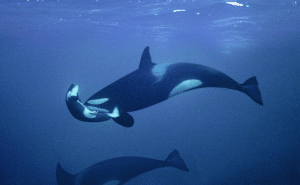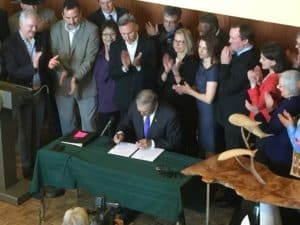 The plight of the southern resident orca whales drew national attention this July, when an orca calf died within a few hours of birth and was carried by its mother, Tahlequah, for weeks after. Sadly, southern resident orca pregnancies from 2008-2014 failed at a rate of nearly 70%. One reason is the severe decline in populations of Chinook salmon, southern resident orcas’ primary food source. Orca numbers are likewise falling: from 98 in the southern Salish Sea in 1995, to only 74 today. Thanks to advocacy by the Lummi Nation and many others, on March 14, 2018, Washington Governor Jay Inslee came to Daybreak Star to sign Executive Order 18-02, establishing the Southern Resident Orca Whale Task Force. The Task Force includes representatives from local and state agencies and governments, Tribes, nonprofits, and businesses. Tribal representatives include UIATF Board Member and Tribal Vice Chairman Bardow Lewis (Suquamish), Chad Bowechop (Makah), Chairman Jay Julius (Lummi), Jeff Dickison (Squaxin Island), Karen Condin (Colville), P. Brent Nichols and B.J. Kieffer (Spokane), Paul McCollum (Port Gamble S’Klallam), Chairman Tom Wooten (Samish), Dave Herrera (Skokomish), Chairman Leonard Forsman (Suquamish), Debra Lekanof (Swinomish), Terry Williams (Tulalip Tribes), and Cecilia Gobin (Northwest Indian Fisheries Commission).
The plight of the southern resident orca whales drew national attention this July, when an orca calf died within a few hours of birth and was carried by its mother, Tahlequah, for weeks after. Sadly, southern resident orca pregnancies from 2008-2014 failed at a rate of nearly 70%. One reason is the severe decline in populations of Chinook salmon, southern resident orcas’ primary food source. Orca numbers are likewise falling: from 98 in the southern Salish Sea in 1995, to only 74 today. Thanks to advocacy by the Lummi Nation and many others, on March 14, 2018, Washington Governor Jay Inslee came to Daybreak Star to sign Executive Order 18-02, establishing the Southern Resident Orca Whale Task Force. The Task Force includes representatives from local and state agencies and governments, Tribes, nonprofits, and businesses. Tribal representatives include UIATF Board Member and Tribal Vice Chairman Bardow Lewis (Suquamish), Chad Bowechop (Makah), Chairman Jay Julius (Lummi), Jeff Dickison (Squaxin Island), Karen Condin (Colville), P. Brent Nichols and B.J. Kieffer (Spokane), Paul McCollum (Port Gamble S’Klallam), Chairman Tom Wooten (Samish), Dave Herrera (Skokomish), Chairman Leonard Forsman (Suquamish), Debra Lekanof (Swinomish), Terry Williams (Tulalip Tribes), and Cecilia Gobin (Northwest Indian Fisheries Commission).
On October 24, the Task Force presented revised draft recommendations to restore the habitat and numbers of our southern resident orca whales. Their final recommendations will be issued by November 16, with a report on progress and lessons learned to be completed by October 1, 2019.
(Photos: Top- Tahlequah and her calf, National Geographic. Right-Gov. Inslee signs EO 18-02 at Daybreak Star Cultural Center)
Current Recommendations
The goals of the task force are to increase Chinook abundance, decrease the disturbance of orcas from vessels and noise and increase their access to prey, and decrease the exposure of orcas and their prey to contaminants. To address the complicated nature of these problems, and to balance the interests of environmentalists, tribes, and other communities, the task force proposes multiple alternatives toward reaching each goal. A key plan recommendation is investing in Chinook habitats, particularly in areas where Chinook stocks will most benefit southern resident orcas. By working with the Washington Department of Fish and Wildlife and regional salmon recovery organizations, the Governor hopes to increase the amount of salmon available to orcas to help them survive and thrive.
Lower Snake River Dams
While many of the task force proposals have broad community support, some groups oppose consideration of the removal of the Lower Snake River dams. Situated in the southeastern part of the state, the Snake River is one of the major tributaries of the Columbia, and has historically been vital habitat for migrating Chinook salmon. Removing the dam, according to groups such as Dam Sense and the Center for Whale Research, would help grow the Chinook salmon population at the rate necessary to sustain the southern resident orca population. However, power companies and Eastern Washington farmers argue that breaching dams would impair their operations, and support other courses of action such as increasing spills.
Treaty Rights
In addition to serving the vital purposes of improving Chinook habitat and protecting orcas, removing the Lower Snake River dams would also improve the State’s compliance with its duty to honor Tribes’ hunting and fishing rights pursuant to numerous treaties signed in the mid-1850s. Dwindling salmon populations have eviscerated the original intent and scope of these rights, which are core to Washington tribes’ identity, heritage, and well-being. While breaching the dams will not solve these problems entirely, it would be a step in the right direction.
Where do we go from here?
We’ll keep you posted on developments in our social media, as the final recommendations are published, a course of action planned, and budget allocations sought.
